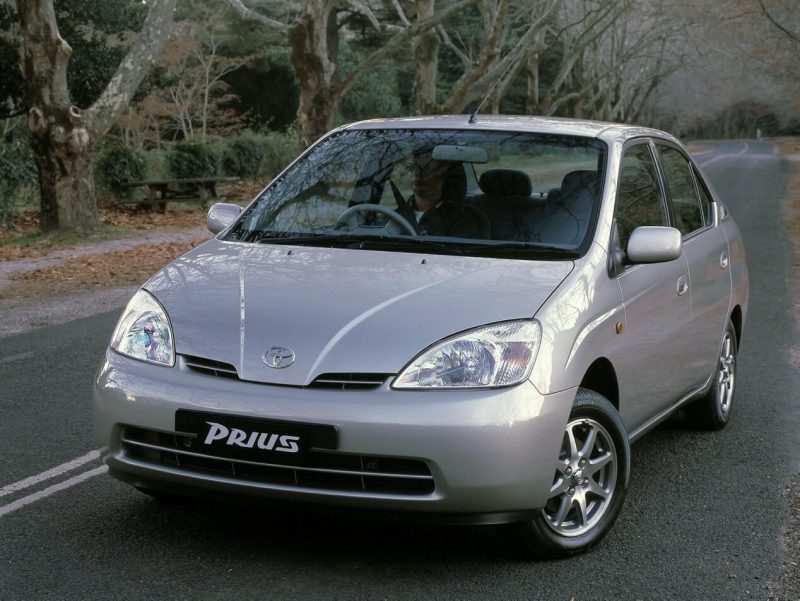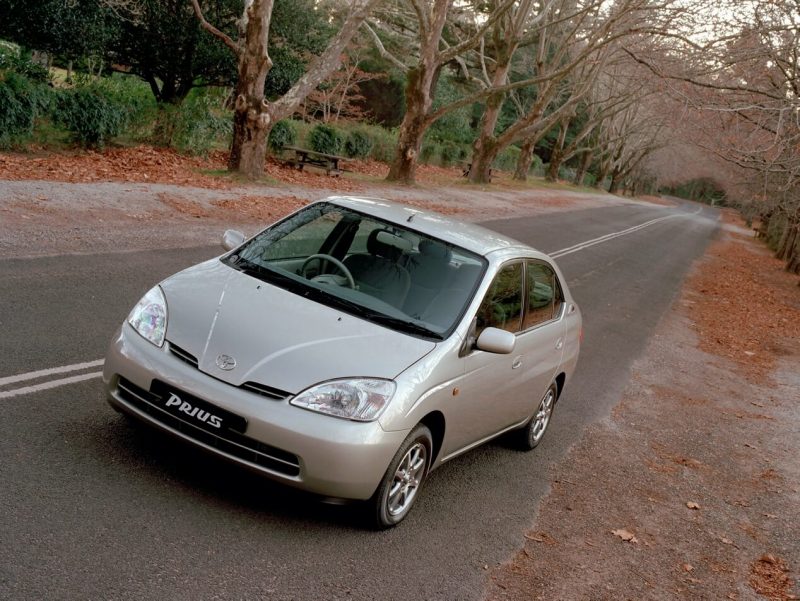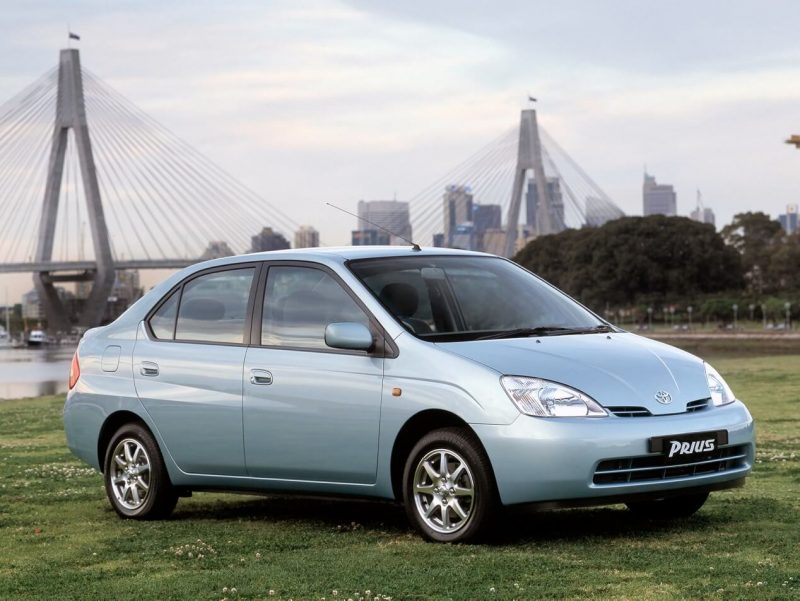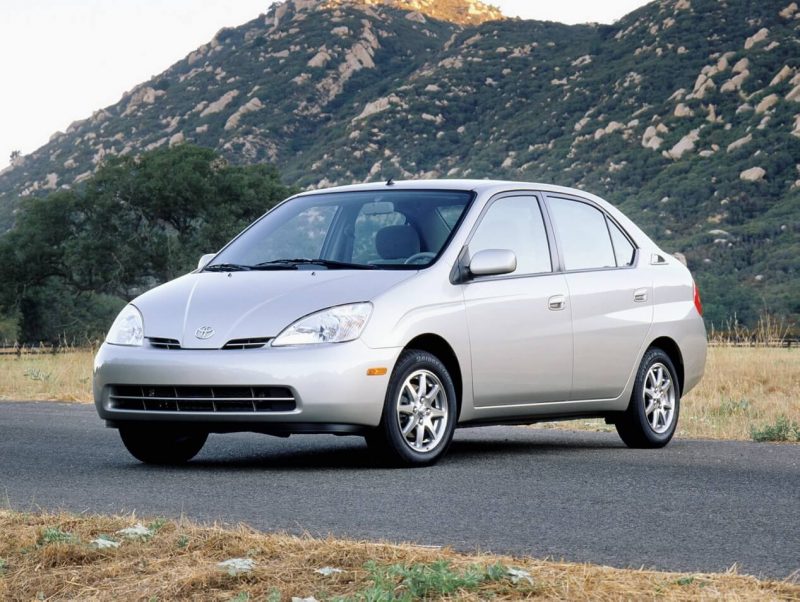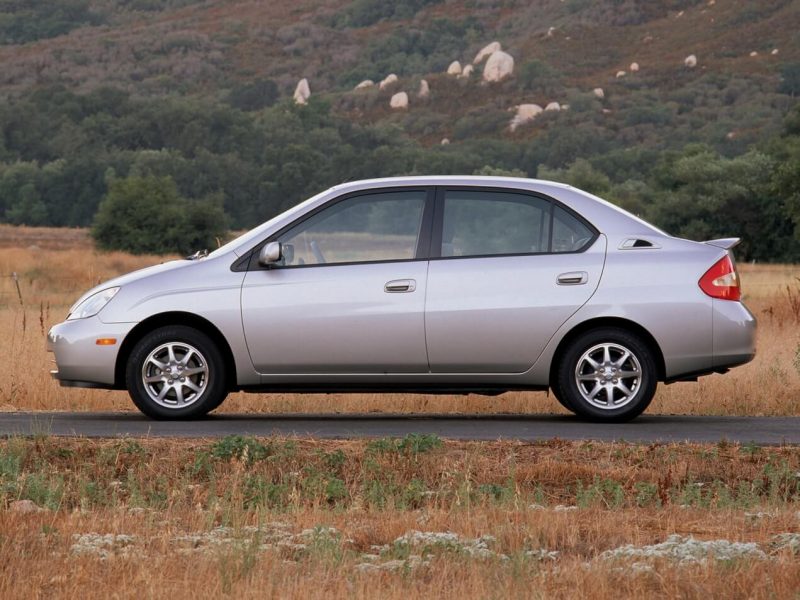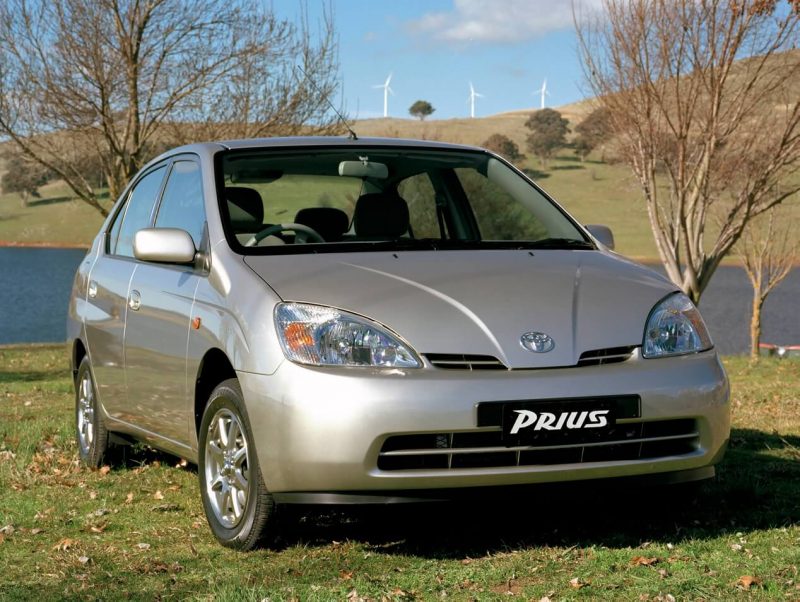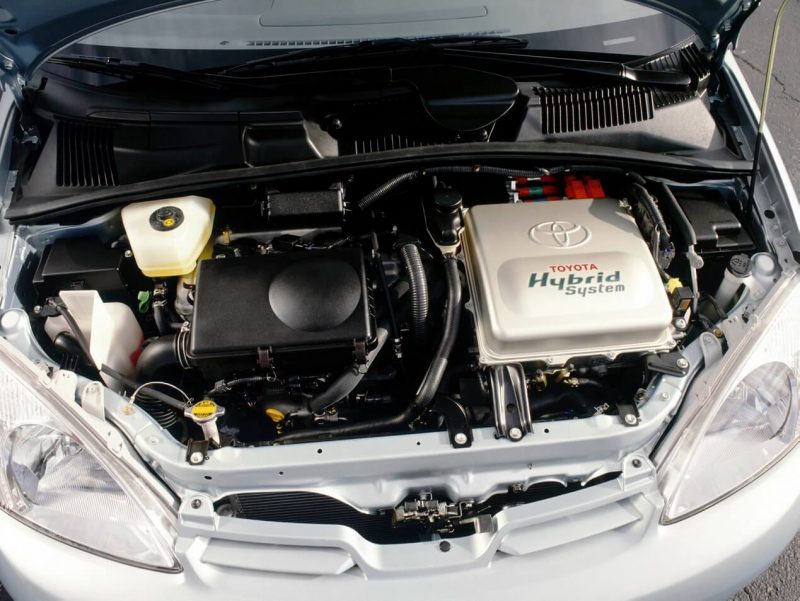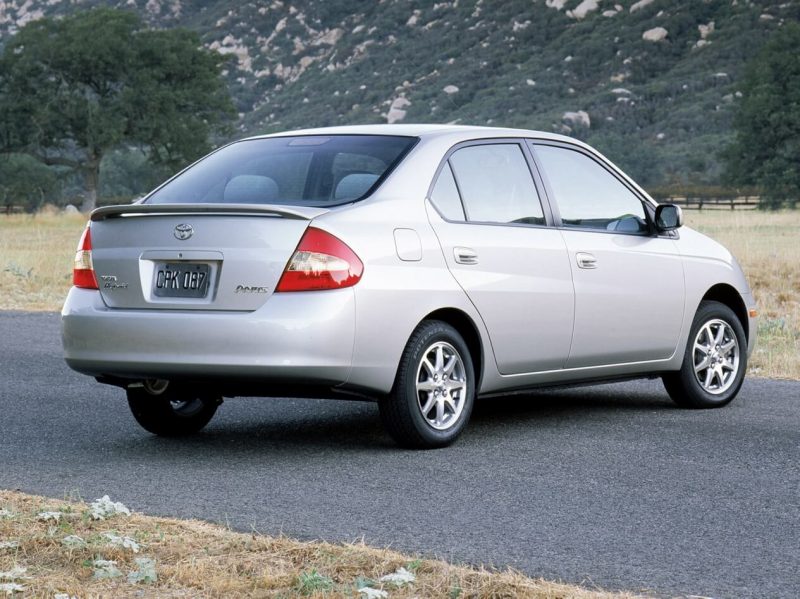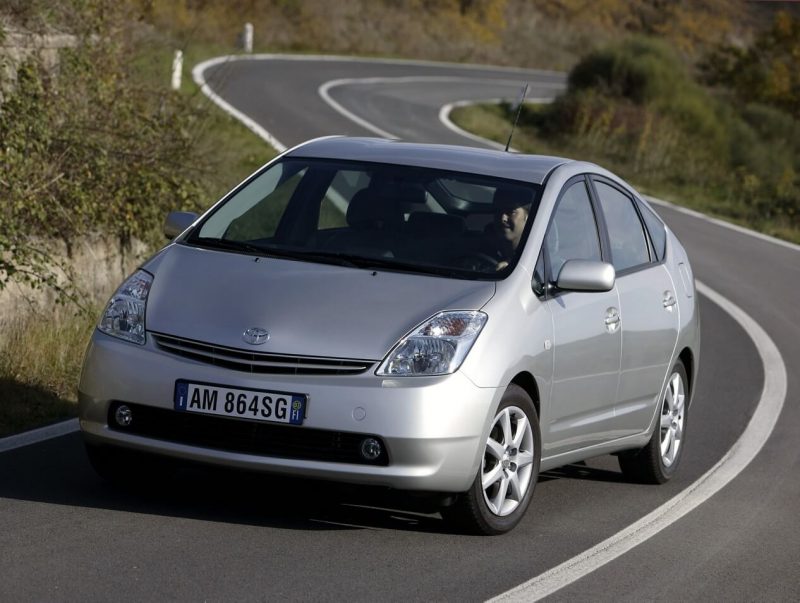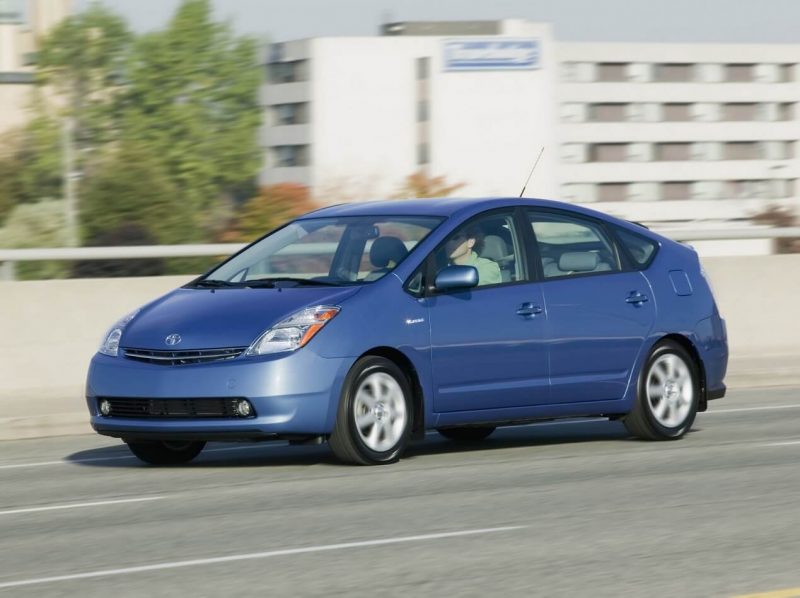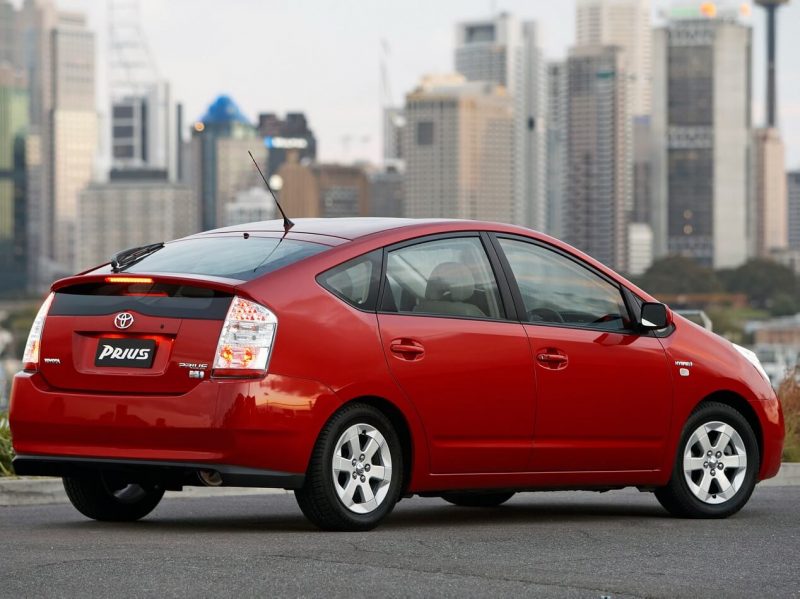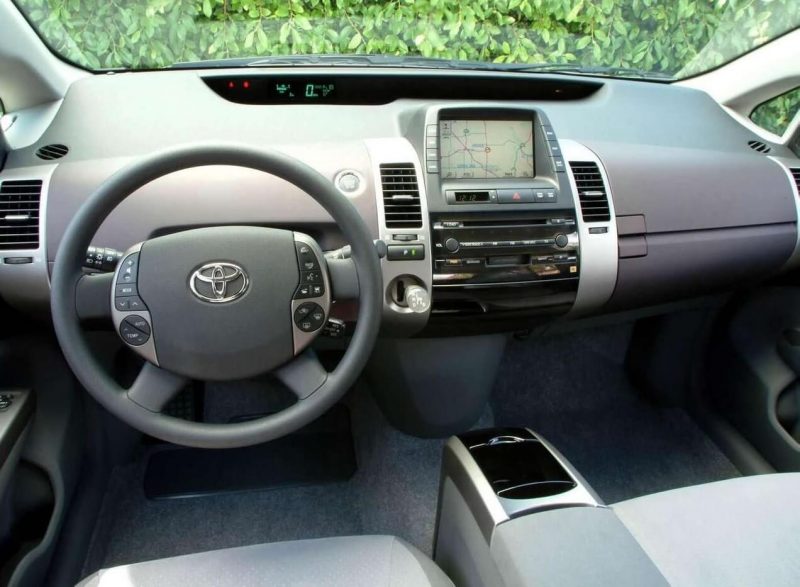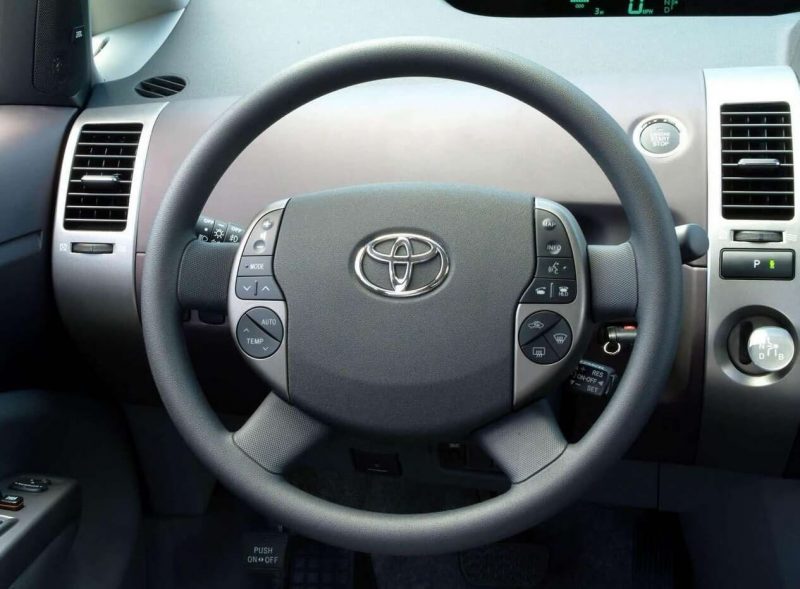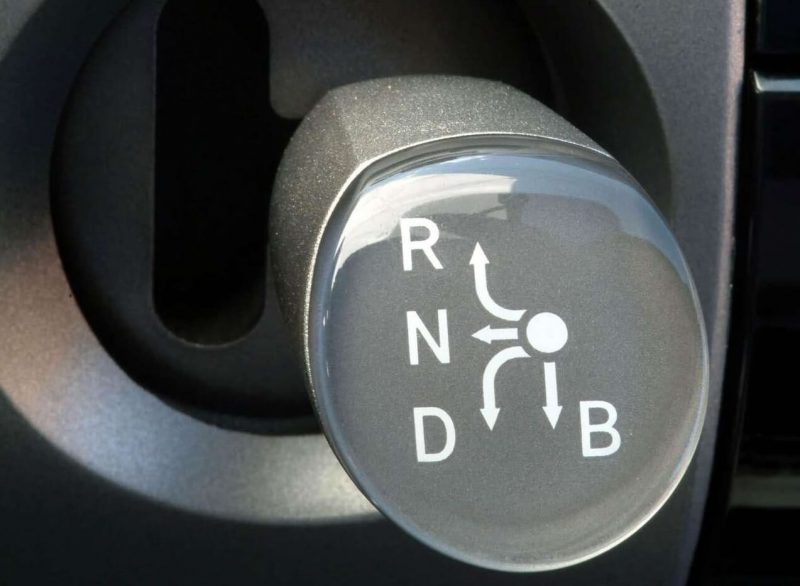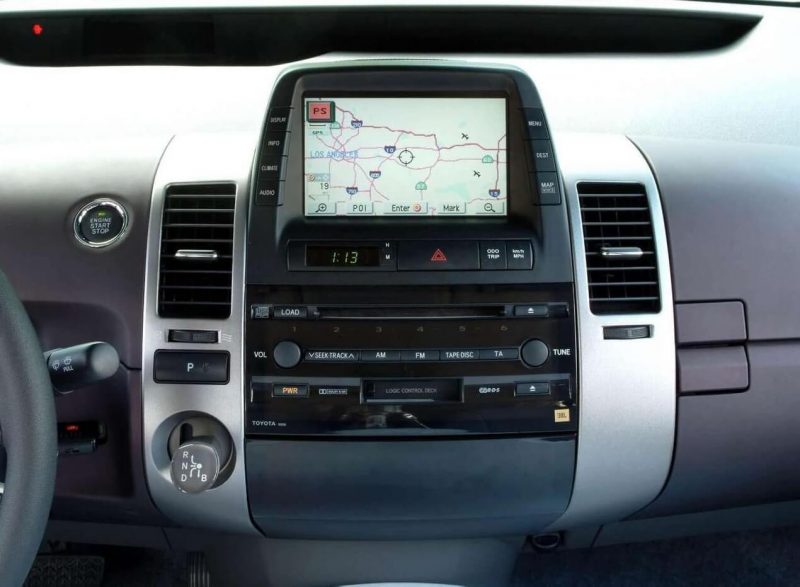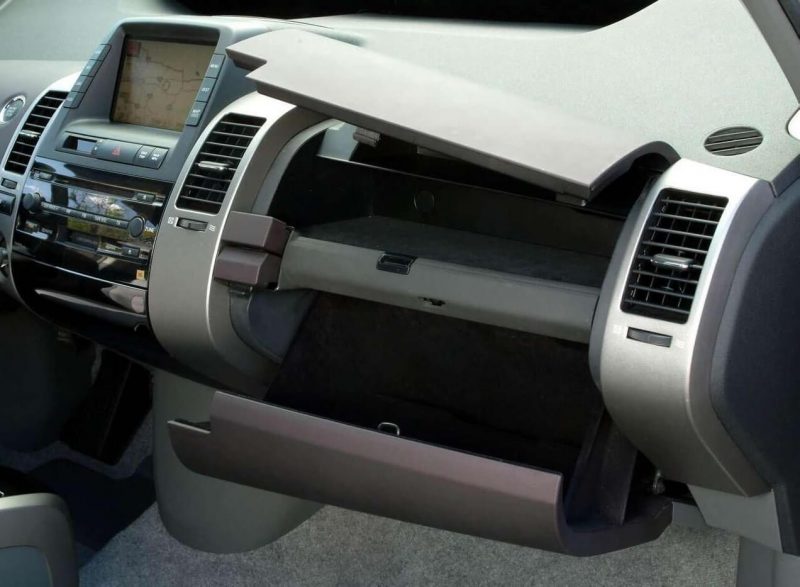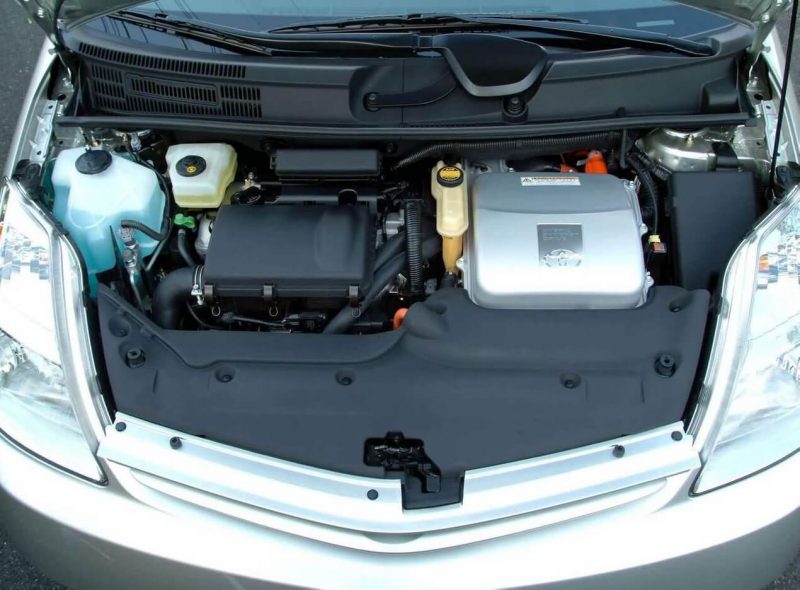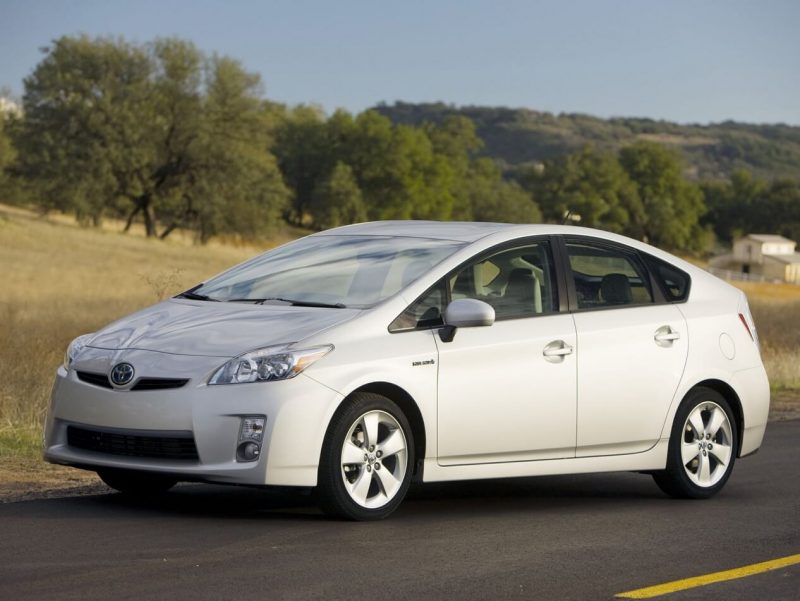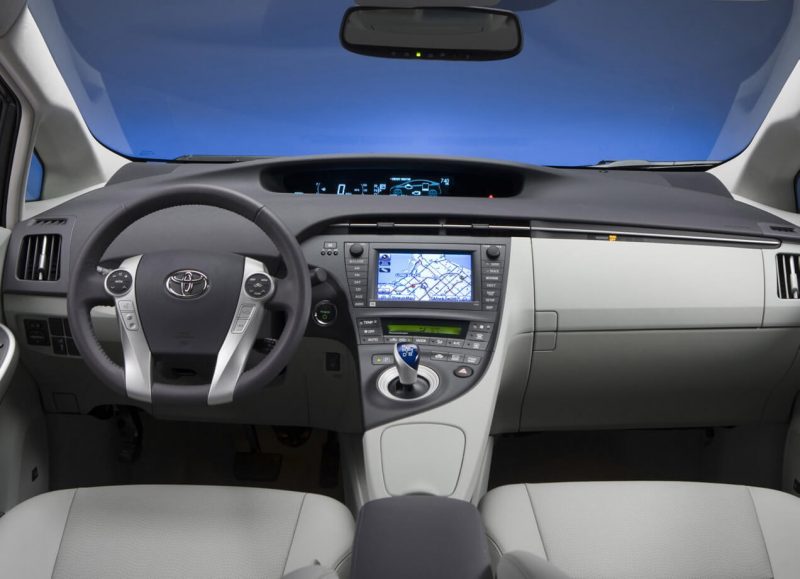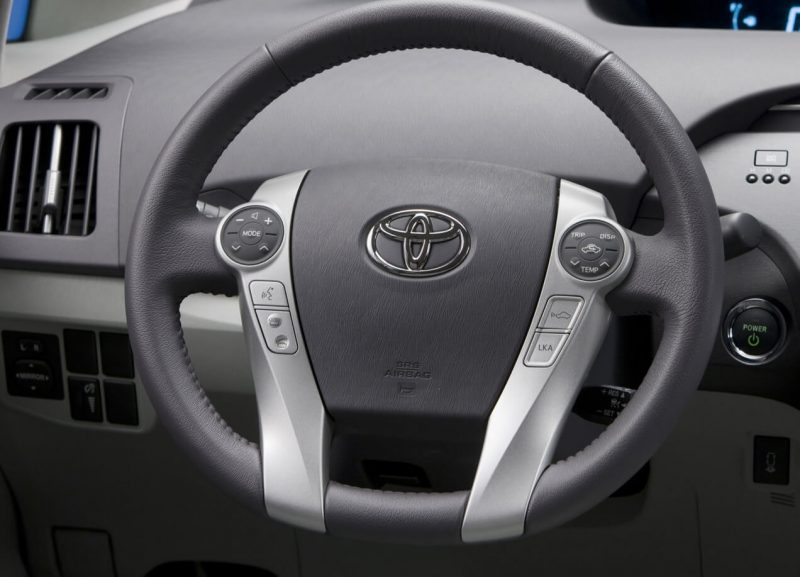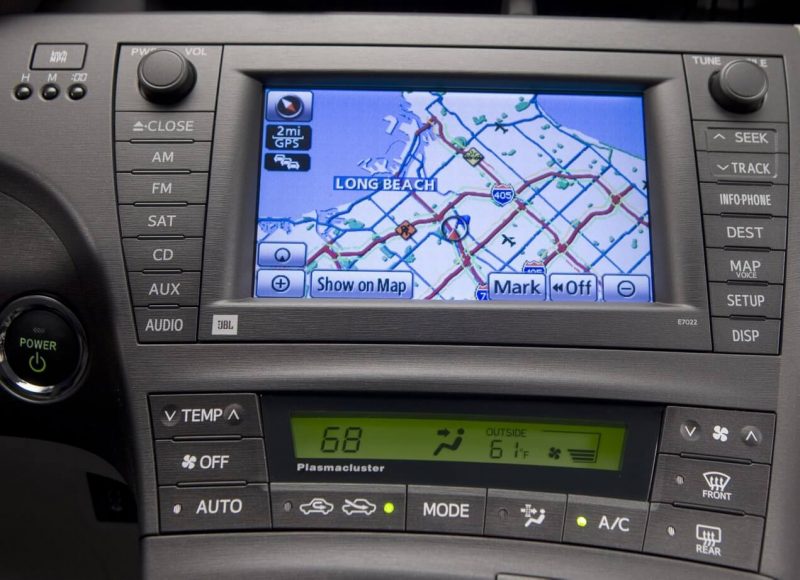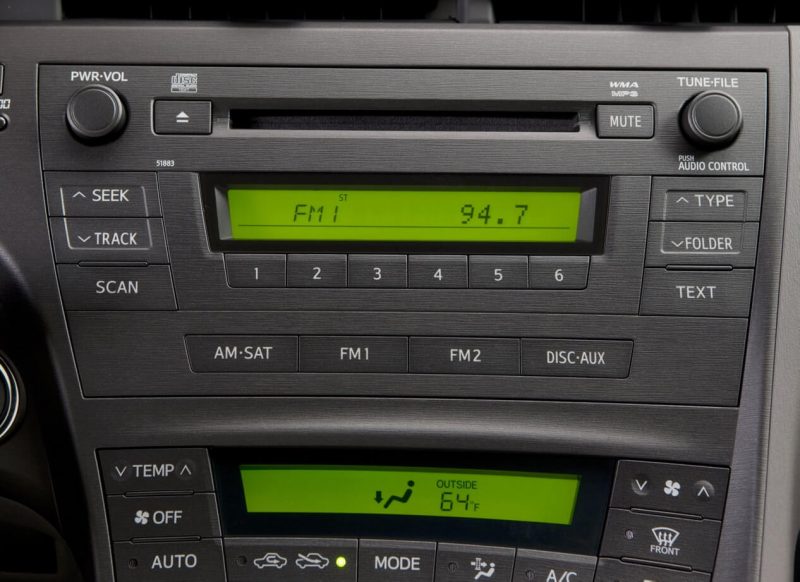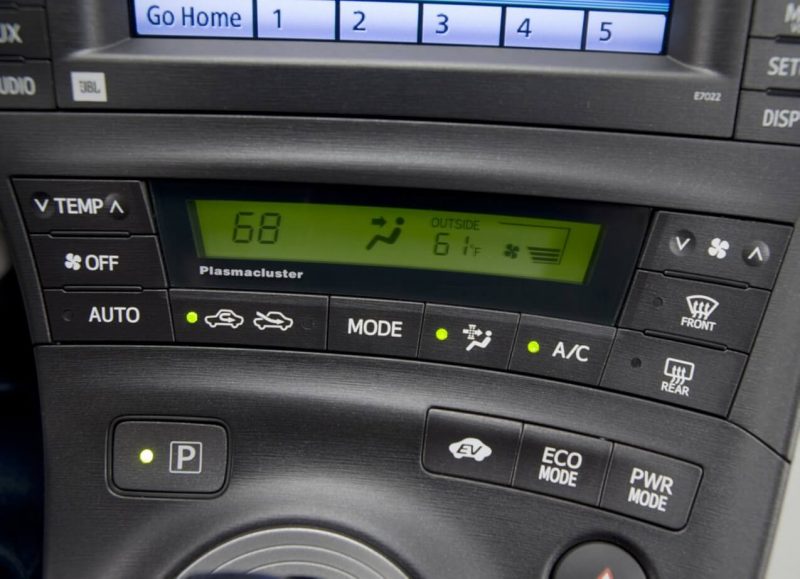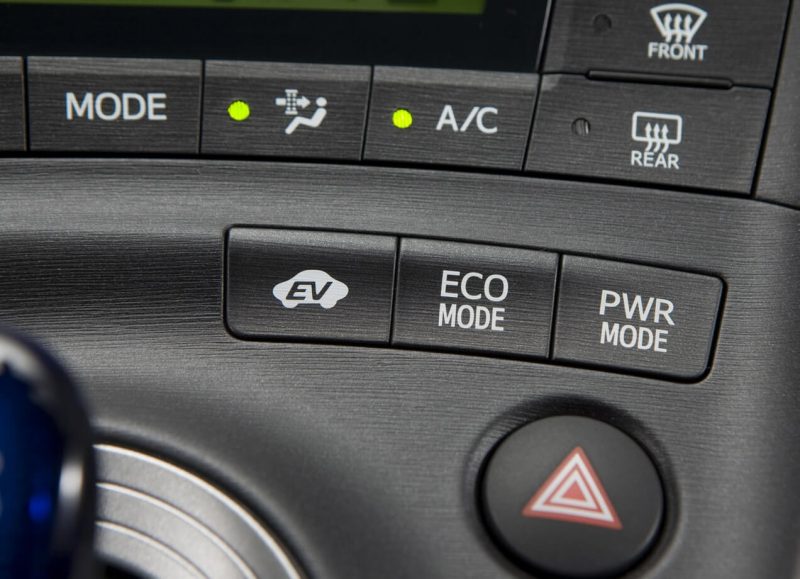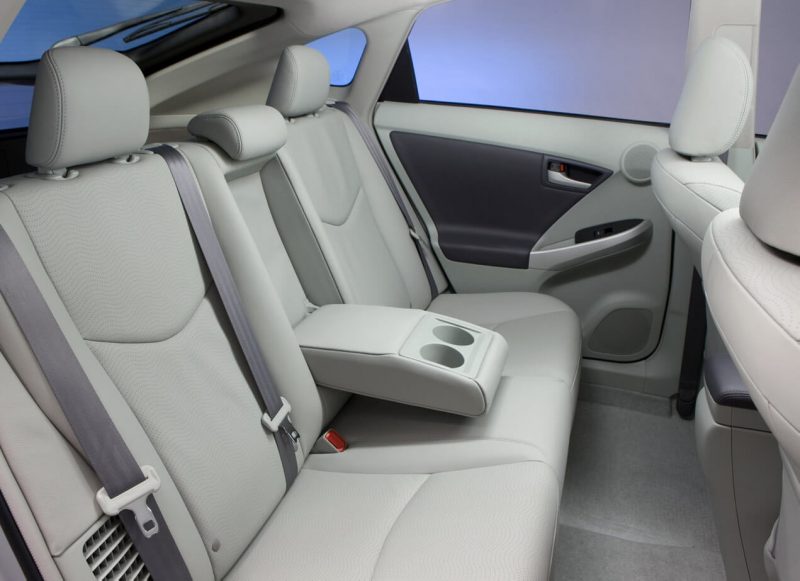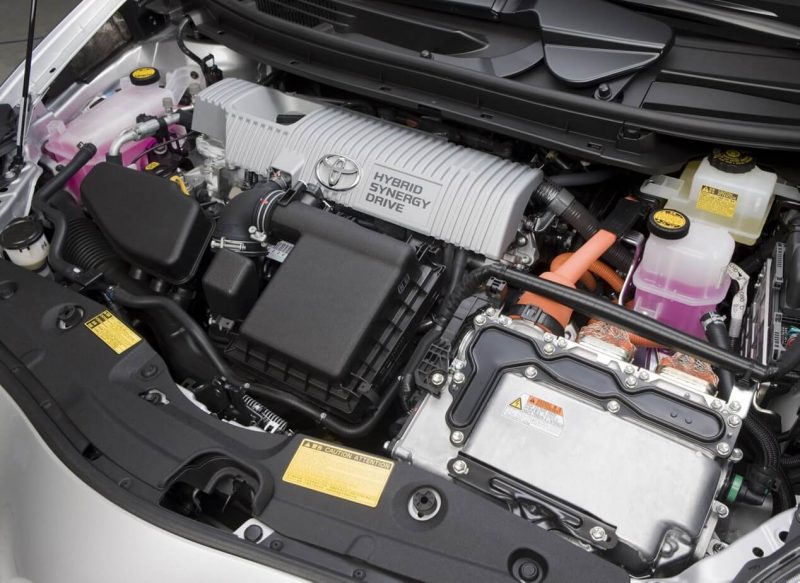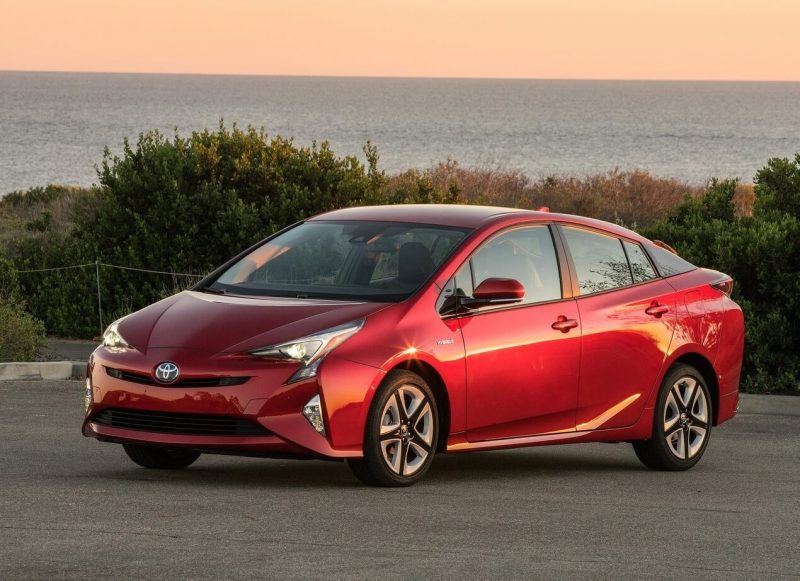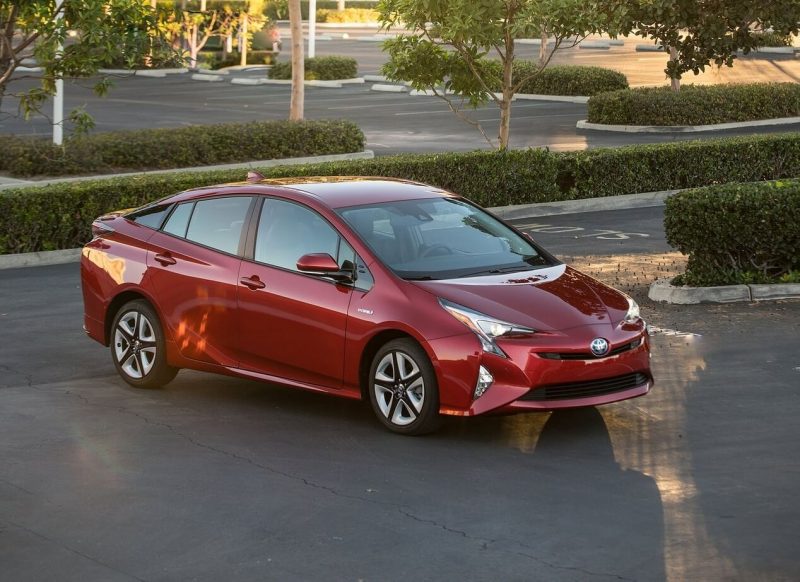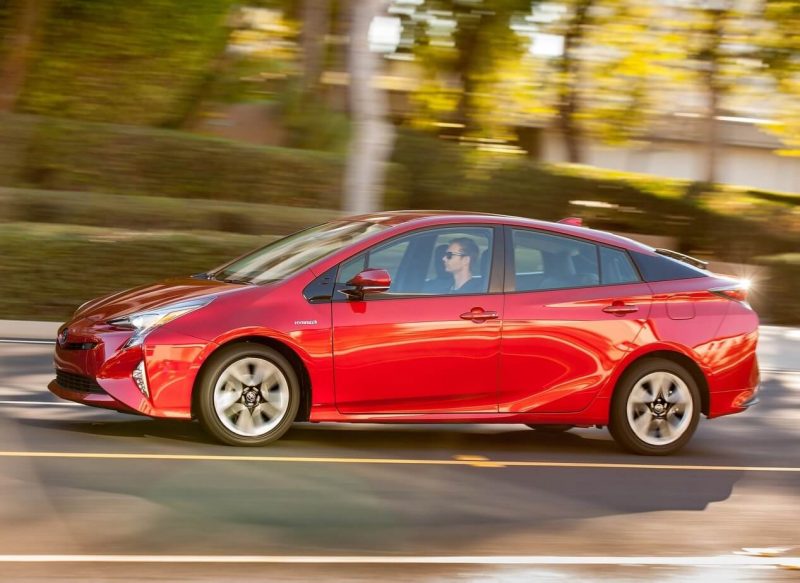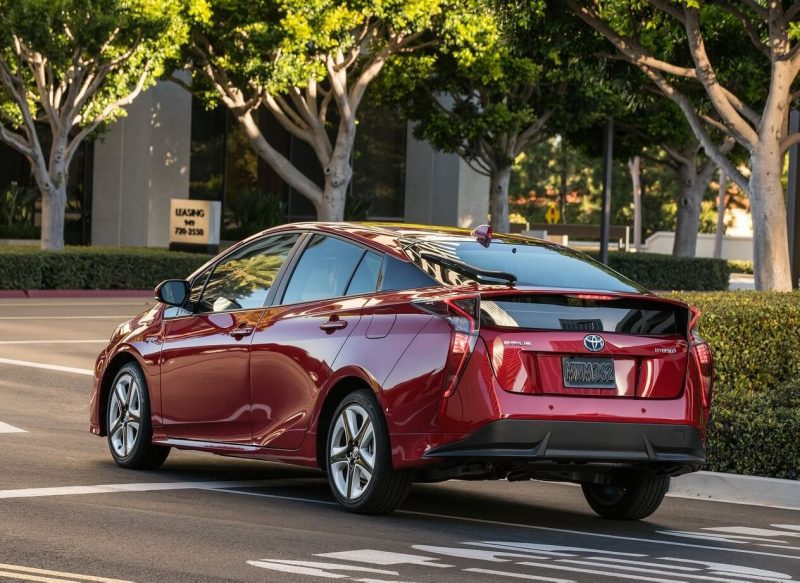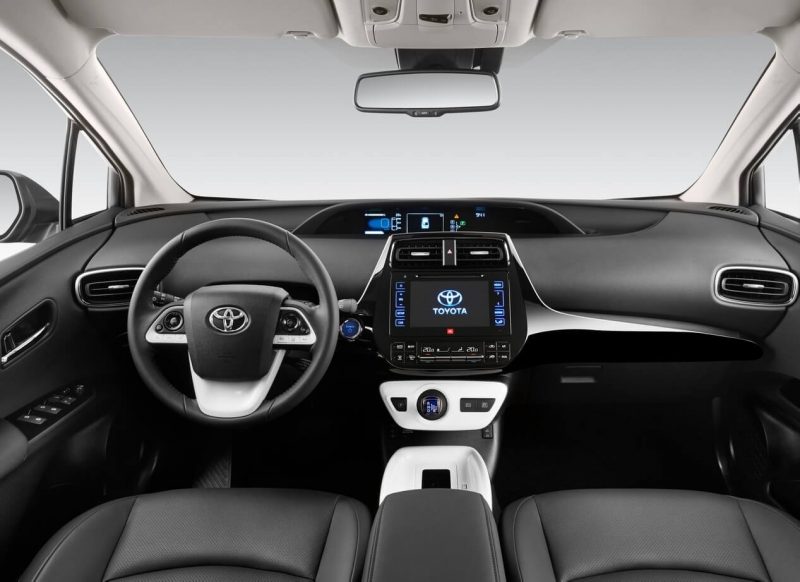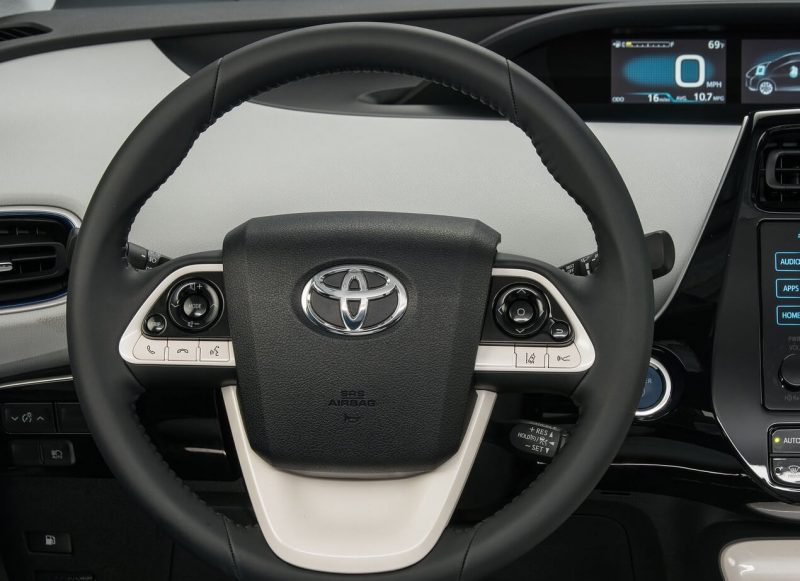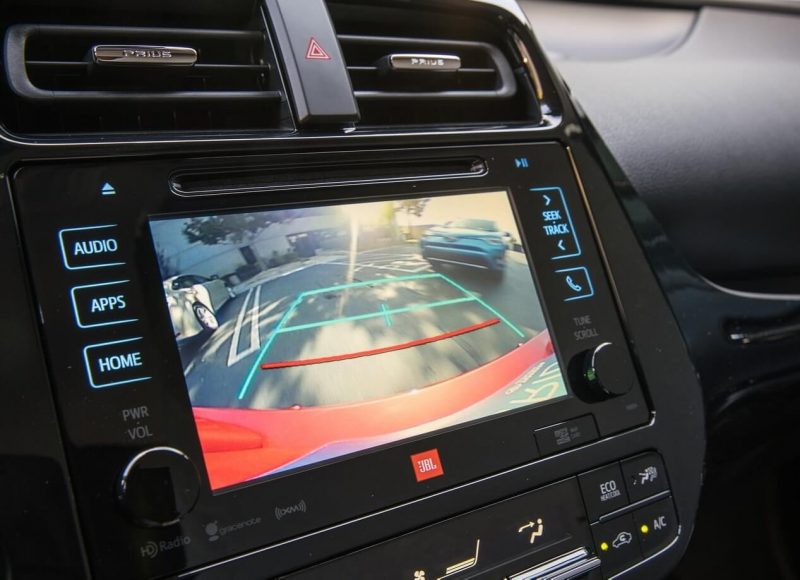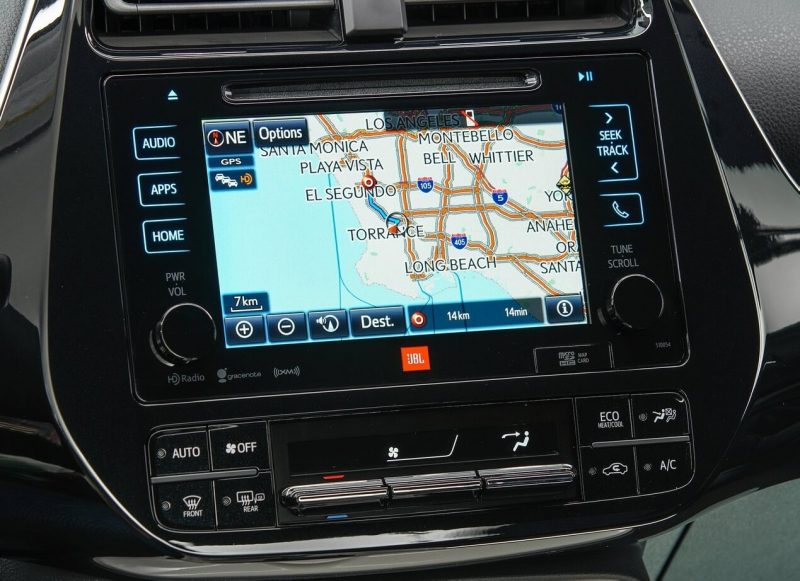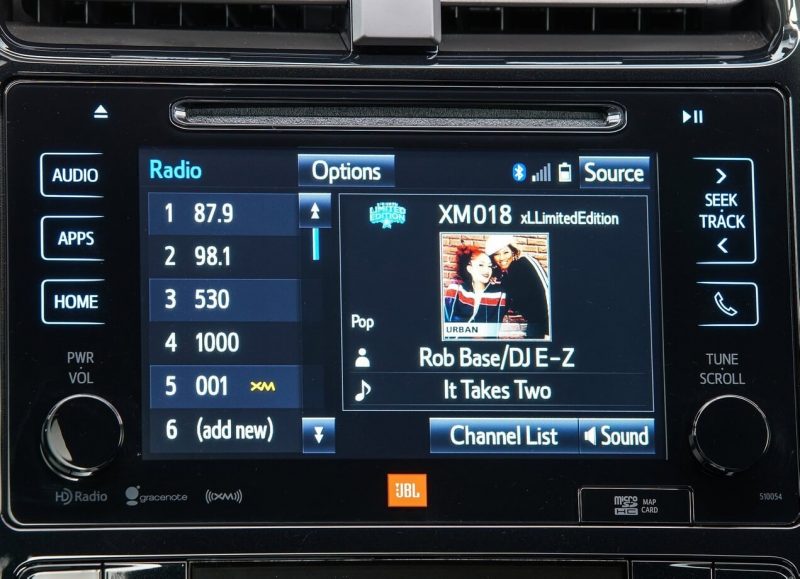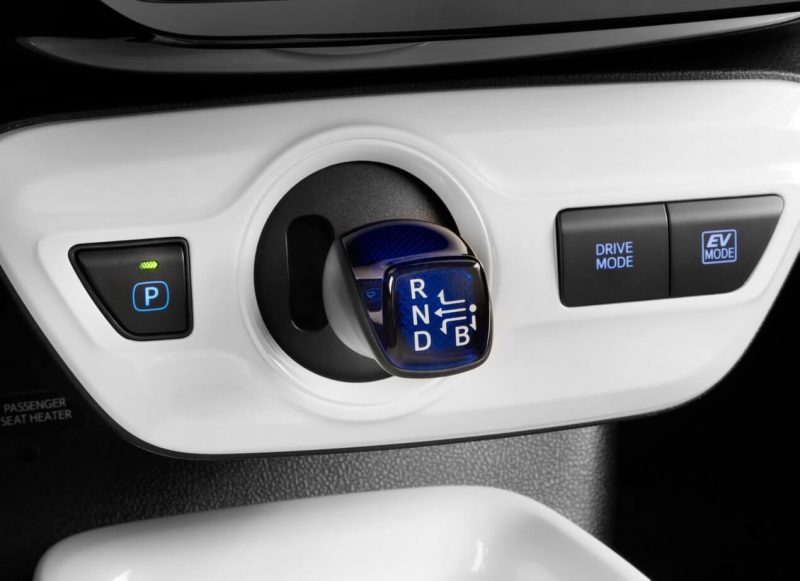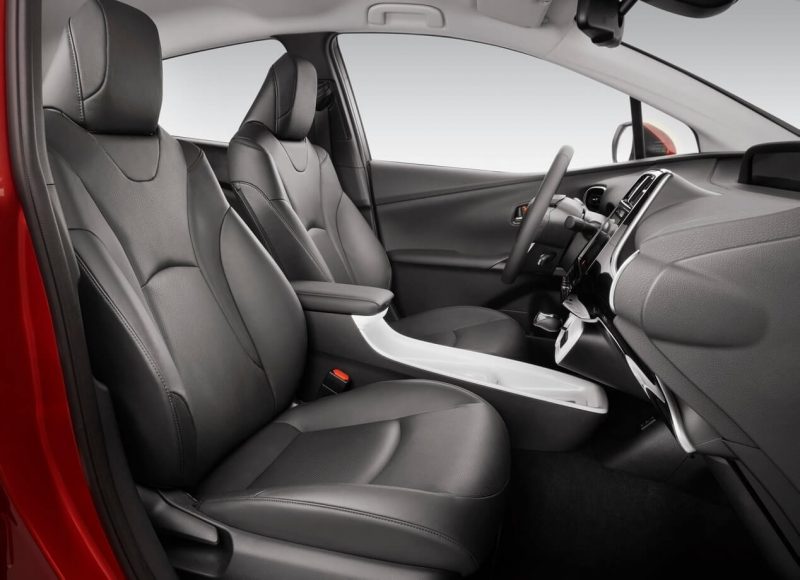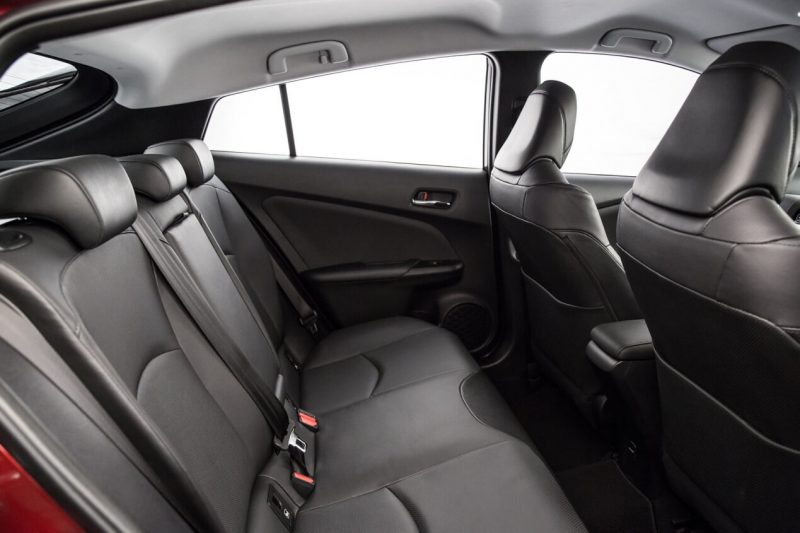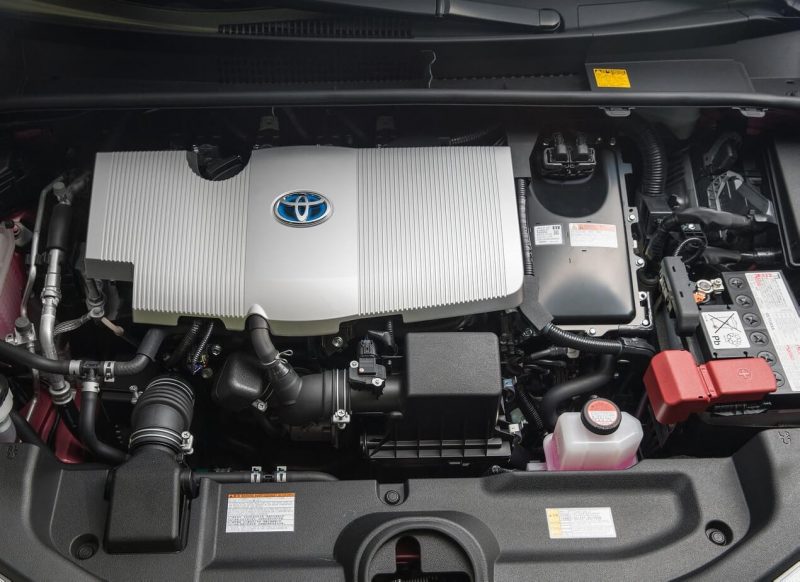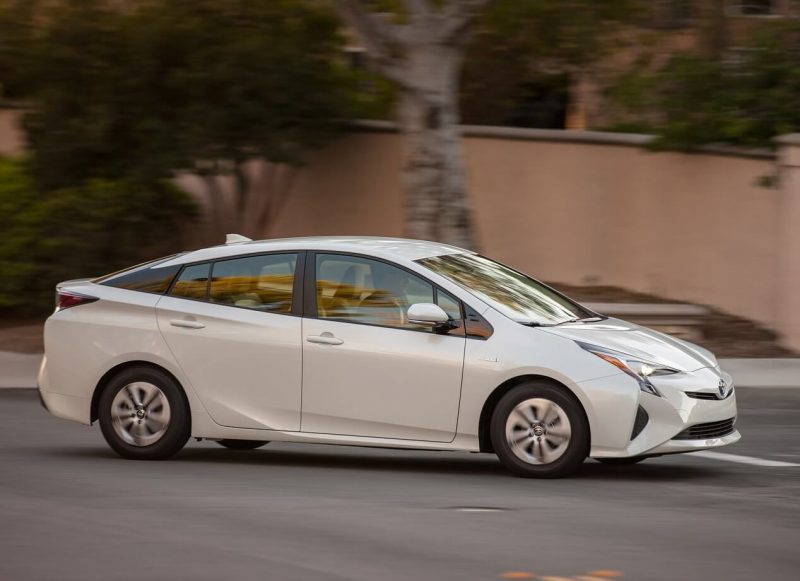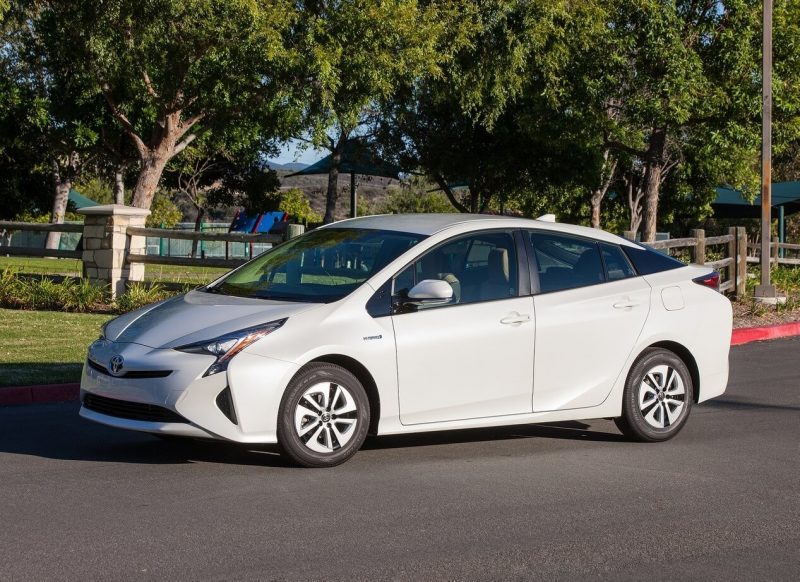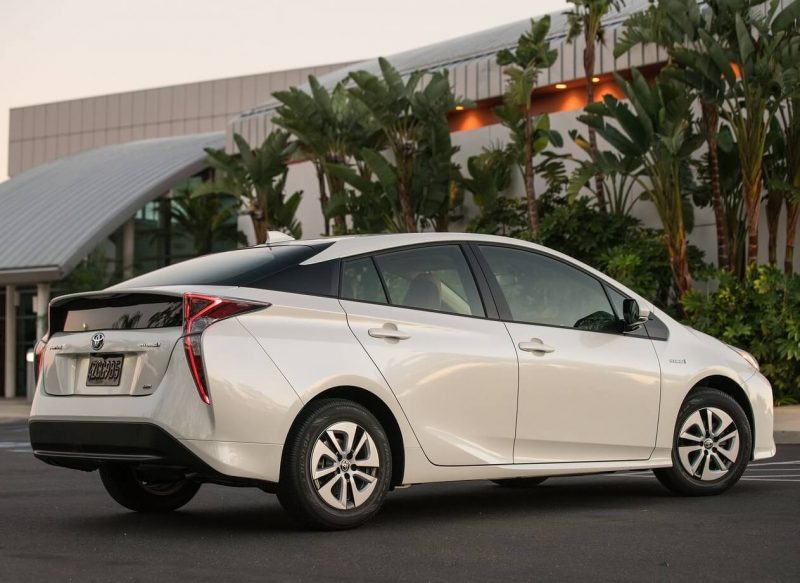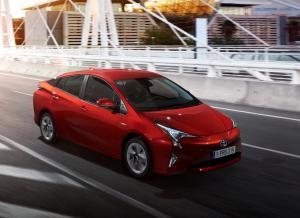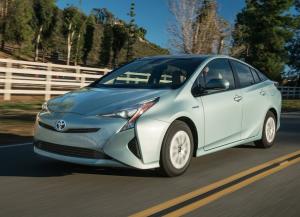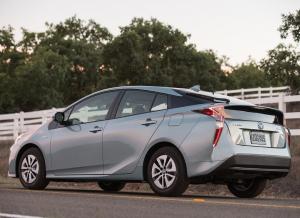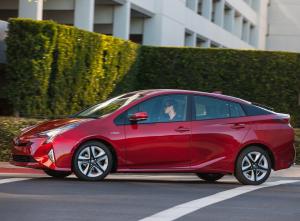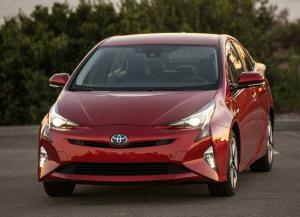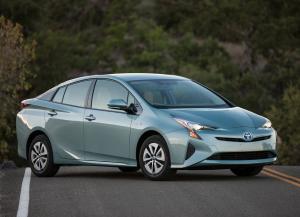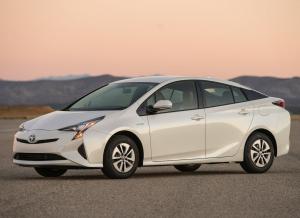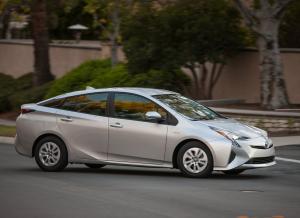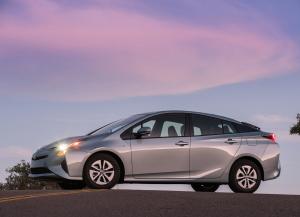Toyota Prius
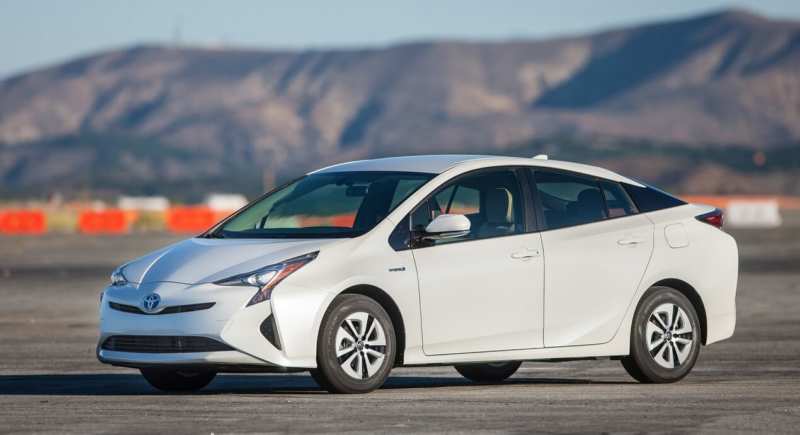
The Toyota Prius family is already in its 4th generation and has not only hybrid versions, but also a hybrid version known as the Toyota Prius Prime. In addition, there are a large number of spacious family cars on the market, but a particularly attractive option is the Toyota Prius V, which comes with five or seven seats.
Also, the line of hybrid vehicles of the Japanese company has its version in the B-class – Toyota Prius C, which debuted in late 2011 in Tokyo. Toyota Prius Alpha is provided for the Japanese market, and for European countries – Plus. You can also buy Toyota Prius PHV (Plug-in Hybrid Vechicle). This model has been produced in Japan since 2012 and is quite a popular car. The whole model range is Toyota.
- Car history
- First generation (1997-2003)
- Second generation Prius NHW20 (2003-2009)
- In appearance and design of II generation
- Generation II Prius Salon
- Specifications II generation
- Three generations of Prius ZVW30 (2009-2016)
- External appearance of the 3rd generation Prius
- Prius III Generation Salon
- Specifications III generation
- Prius III Generation Costeffectiveness and Equipping
- Generation IV Prius Exterior
- Generation IV Prius interior
- Specifications IV Generation
- Mower units and battery
- Transmission
- Carriage
- Security
- Complete sets and prices
- Owner feedback
- Toyota Prius competitors
- Pluses and minuses
- Summing up
- Toyota Prius 2017 photos
- Test drive
- Video overview
Car history
During the Kyoto Protocol, which was signed in 1997, many States committed themselves to reducing toxic emissions into the air. Given the fact that Japan was one of the pioneering countries, a large number of massive Japanese enterprises decided to introduce a range of programmes to reduce emissions. Toyota Motor was one such firm.
Such documents were able to identify one of the most prevalent trends in the activity of the company today – the development of the latest environmentally friendly technologies. Taking into account this program, several types of engines were being developed, including a hybrid engine, which was formed in 1997 on Toyota Prius Hybrid vehicles.
First generation (1997-2003)
They started to develop cars with hybrid equipment back in 1994. The engineering staff was set the most important goal: to create an electric engine and an energy source, which will be able not to replace, but productively complement the main internal combustion engine. The very name “Prius” from Latin means the first, original.
The debut embodiment of Toyota Prius of the first generation was shown to the public in autumn 1995 during the Tokyo Motor Show as a conceptual model. But its mass performance, which was marked by the index “NHW10”, went on sale with dealers only at the end of 1997. The hybrid model was produced until 2003, after which it was replaced by a new family.
Based on the words of the Toyota engineers, they tested more than a hundred varieties of different schemes and layouts, which provided the opportunity to actually design a productive scheme under the name of Toyota Hybrid System.
The Toyota Prius of the first generation is a four-door golf sedan of the appropriate external parameters: length – 4315 millimeters, height – 1475 millimeters and width – 1695 millimeters. The wheelbase of the car is 2550 millimeters, and the height of the ground clearance is 140 millimeters.
The curb weight of the Japanese hybrid vehicle varies from 1 240 – 1 254 kg, depending on which version. If we mention the above described THS system, which is a combined power plant, it consisted of an internal combustion engine, a pair of electric motors and a stepless gearbox HSD.
The 1.5-litre 1NZ-FXE gasoline engine produced 58 horsepower. The total power of the electric motors was 30 kW. The electric motors are powered by the energy stored in the high voltage batteries with the reserve of 1.73 kWh.
The most important feature of the engine is that the electric motors could still function as a generator – during the movement on the internal combustion engine, as well as during regenerative braking, it was possible to charge the battery. That’s why you could use it again after a while. The motor itself was of the Atkinson-type type, with an average urban fuel consumption of between 5.1 and 5.5 litres for every 100 kilometres.
The electric motor can operate alone from the main engine or in a joint order, which has contributed to faster acceleration to a more economical transmission. These innovations have reduced the number of toxic emissions into the air to almost 120 g/km. To better understand this, we can compare the hybrid “hypermachine” Ferrari LaFerrari, which has this figure of 330 g/km.
Toyota Prius of the first generation was installed on the front-drive platform “Toyota MC”, where there was an independent chassis in front with McPherson racks and behind with a four-lever system. The hybrid vehicle has a rack and pinion steering equipped with electric power steering.
The front wheels have ventilated disc drives, and the rear wheels have simple drums. Already in the basic configuration there is an ABS system. Despite all the advantages and efficiency, the Japanese car Toyota Prius Hybrid was met with quite cold blood.
Partly because of the kind of power equipment that is not powerful enough even for a measured ride of a car weighing more than 1200 kilograms. To fix this situation somehow, the management decided to improve the power equipment in the modification of NHW11.
As a result, the capacity of the internal combustion engine increased from 58 to 72 horses and the capacity of the electric motor from 30 to 33 kW. In addition, through minor improvements to the energy storage system, the high voltage battery capacity was increased to 1.79 kWh.
Second generation Prius NHW20 (2003-2009)
During the demonstration of the new vehicle, a representative of the company made a statement:
We decided to put the first concept behind us and started working from scratch.
Actually, that’s what happened. If before there was a small sedan, the 2nd family represented a huge five-door hatchback. Thanks to the modernized hybrid drive, it was possible to significantly reduce gasoline consumption.
A new mode of driving was introduced, working exclusively on electric traction: exhaust gases were not produced and the car should be almost silently. In the summer of 2003, second-generation vehicles were launched at the Tsutsumi Plant in Toyota, Japan. Two years later (in 2005), the assembly was organized in Changchun, China.
They assembled the machines in a common factory with FAW. Before the round date of the hybrid car (10 years since production) in December 2007, a total of about 900,000 vehicles were sold. Vehicle production continued until 2009, after which, in spring, the company officially introduced the 3rd generation vehicle.
In appearance and design of II generation
A completely different hatchback-shaped body became bigger, however, the short hood, together with the inclined headlights, saved the style of unity with the 1st family car. Many hours of specialist work on the fine-tuning of the machine’s appearance in the wind tunnel, allowed us to guarantee the necessary balance between appearance and streamline.
The unique triangular profile ensures that the Toyota Prius II generation has the lowest drag coefficient in the segment – 0.26. Part of the reason for this is the almost flat bottom, the rear window spoiler and the rear bumper, which is similar to the sports car diffuser.
To reduce weight and increase structural rigidity, the steel used high strength steel, and the hood, together with the luggage compartment lid, was made of aluminum. Interestingly, the battery shell was also used to reinforce the aft bodywork. The car can have six airbags, and the built in airbags already in a base complete set have two-stage opening.
With the help of a special sensor of the driver’s seat position, it is possible to calculate more accurately the time of his pillow operation. The car was mainly able to successfully pass American, European and Australian independent crash-tests. Only the Insurance Institute of America has allocated not good enough degree of protection of passengers during the side impact of hatchback without side Airbags.
Increased safety has been achieved with the installation of 2 LED stop lights on the Toyota Prius, which are ten times faster than conventional lamps. On top of that, they don’t consume as much electricity as they do.
When 2005 came, the specialists of the Japanese company carried out a small modernization of the machine. The front fenders received the text “Hybrid”, on the grille, in the center was used a strip of chrome, and the headlights and taillights slightly changed.
Generation II Prius Salon
The inside of the car became much better, the ergonomics improved. The Toyota Prius II had a high seating height, which improved visibility and made entry and exit easier. The oval steering wheel was not disturbed by the fact that it contained additional keys for setting up the music system, ventilation and phone.
Voice control of these options was provided. All basic models were equipped with Bluetooth to communicate with the smartphone, as well as a 7-inch touchscreen display used for navigation, hybrid system control and important information output.
Near the steering wheel, the designers placed an electronic switch of transmission modes, which resembled a game joystick on the computer. The hand was lying on this joystick, and it was so easy to move it that it was carried out even with the help of fingertips.
When the signal was given to the transmission control unit, the spring-loaded small lever became in its basic position on its own. The 2nd generation Toyota Prius did not have an ignition switch, and to start it, you had to press the “Power” button on the front panel.
The “electric key” itself had to be inserted into a special slot located near the steering wheel. There was a variant of ordering a “smart” key, which could open and close the doors and luggage compartment automatically. All you had to do to start the system was just put it in your pocket.
For the first time, the machine, which was produced in a conveyor version, had an air conditioner, which had an electric drive of the compressor. In addition, the electric motor was used to drive the water pump of the cooling system “engine”, which also serves the heater.
It turns out that the “climate” system was able to function independently of the gasoline engine. After the updates in 2005, new upholstery materials were used inside the hybrid car, and the rear sofa became a little wider.
Specifications II generation
The main novelty of the modernized hybrid system THS II was a 2-fold increase in the supply voltage of the electric motor. Thanks to this, its power increased up to 50 kW, it began to turn on and operate more often for a long time, which, in turn, allowed to unload the gasoline “engine”. All this led to fuel saving and reduction of emissions into the atmosphere.
This AC synchronous motor, which is fully developed by Toyota, has received an optimized rotor shape with special magnets. The generator’s speed limit has increased from 6500 to 10000 rpm. As a result, it increased its efficiency at the average speed of the internal combustion power plant.
The newest inverter was 20 percent smaller, and together with the conversion of DC from battery to AC, it increased the voltage from 201.6 to 500 volts. Since the units generated a lot of heat, they had their own liquid cooling system.
The four-cylinder, 1.5-litre gasoline engine, which operates on the cycle of the aforementioned Atkinson, now had increased power to 77 horsepower, thanks to the increase in its maximum revolutions. In addition, the engine has been redesigned with lightweight pistons and piston rings with reduced friction.
The engine was started quickly and smoothly due to the electronic system that precisely controls the crankshaft position when it is stopped. The electric motor, together with the generator and the gasoline engine, was combined with a planetary gearbox.
If we talk about the nickel-metal hydride battery, which was specially designed for the second family car, it lost 14 percent of its weight and received 35 percent more charge density. This has been achieved through the use of improved electrode elements and an optimized cellular connection system. Importantly, the battery was 23 per cent less discharged, allowing a longer time to maintain charge when the battery was not running.
The “combined” performance of all power units was 110 horsepower. This allowed the vehicle to reach a speed of 170 km/h, and the first “hundred” was given a hybrid in 10.9 seconds. The average consumption of the car did not exceed 4.6 liters of gasoline in a combined cycle for each hundred kilometers.
The Toyota Prius 2 features the Toyota MC front-drive architecture. The Japanese hatchback has independent front and rear suspensions, with McPherson racks in front and a multilever system in the back. The elevator also features a rack and pinion steering system, which is complemented by an electric booster.
The Toyota Prius 2 braking system has disc brakes at both the front and rear. The front units are equipped with a ventilation function that works together with ABS and other electronic fillings.
Three generations of Prius ZVW30 (2009-2016)
The hybrid version of the Toyota Prius 3 generation was officially launched for the first time in early 2009 during the international car show in Detroit. The vehicle is now available for sale closer to summer. The vehicle was able to keep the platform of the previous model, but in all other moments the car has changed significantly.
Six months later, the Prius Plug-In concept-version, which can be charged from a simple socket, debuted, but serial production of the car was launched only in 2011. The five-door model remained in production until 2015, after which it was replaced by a new, fourth generation of Japanese hatchback.
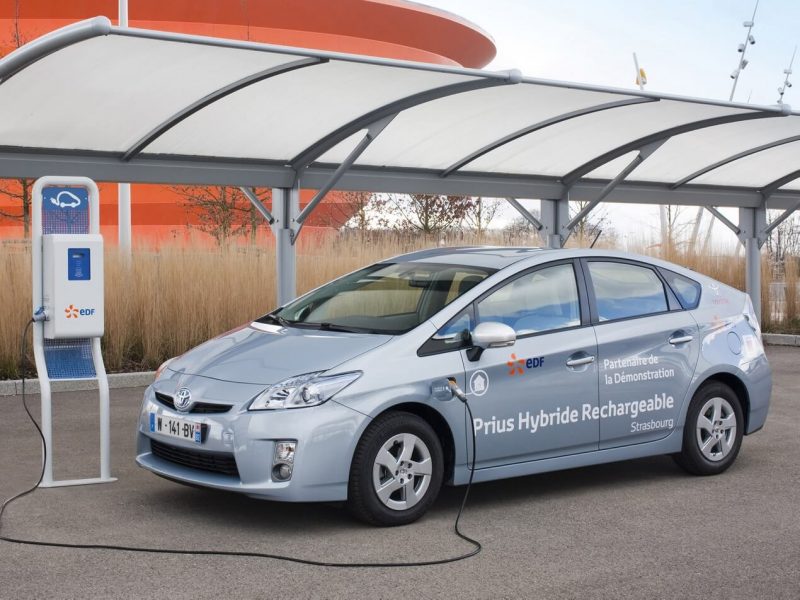
Despite some commercial success, Toyota’s engineering staff continued to upgrade the vehicle to increase its autonomy in the application of clean energy and subsequent emission reductions. On the platform of the THS system, a brand new Hybrid Synergy Drive hybrid transmission has been developed, which works by analogy, however, with a list of significant conversions.
External appearance of the 3rd generation Prius
Toyota Prius’ thrash exterior is modern, recognizable and original. Japanese designers were able to make a distinctive car that can quickly stand out from the crowd of “classmates”. It is clear that the most exquisite car can not be called a hatchback, but its appearance has a certain elusive appeal and balance, which is not found in every vehicle.
Initially, during the design of the machine, the design staff, together with experts on the aerodynamic component, worked hard together to get a very low aerodynamic resistance – 0.25. With this in mind, the specialists were able to maintain the ratio of the standard “Prius”.
To do this, the open area of the grille had to be reduced as much as possible. Thanks to the flat sides of the front and rear bumper, it is possible to direct the air flow around the wheel arches, which reduces turbulence.
At the bottom of the vehicle has special shields in front of the wheels and panels that cover the engine, as well as elements of the suspension and gas tank, which contribute significantly to the unified aerodynamic performance of the novelty.
Prius III Generation Salon
Inside the “Japanese” looks quite usual, and only a 2-layer screen, which is viewed from the “cave” on the upper part of the front panel and replaces the standard devices, as well as the 4-spoke steering multifunctional wheel with a rim flattened at the bottom, adds its specifics to the interior decoration.
The central console has a 7-inch touch screen multimedia system, a “microclimate” block with a monochrome narrow horizontal display and joystick transmission. Inside the vehicle only high quality materials are used, and as for the assembly itself, it can be said that it is at a good level.
The front panel itself is divided into 2 areas. All controls are conveniently located on the console, which seems to weigh in the air. Above it there is a control lever for driving modes, and below plenty of space for storing trifles. Basic equipment Toyota Prius 3 generation has a system of projection on the windshield of the main parameters of the machine.
Interestingly, that the air conditioner can be switched on remotely in 3 minutes before landing in the car. With the help of an electric motor, the compressor was powered by VVB and provided cool interior space. And when it was hot, thanks to the solar panel built into the roof, the electricity it generated was enough for a special fan to ventilate the salon.
This was very convenient because the electronics did not require any auxiliary energy and did not allow the interior of the machine to overheat. The front of the Toyota Prius 3 cabin has comfortable seats with a middle side stop, acceptable setting ranges and a heating function.
The second row can even accommodate three people. There is enough space for everyone. Luggage compartment 3 of the family according to the class criteria is quite spacious – 445 liters. If you add up the rear seats, this figure will grow to 1120 liters of useful space. Besides, you will get a full-fledged flat floor.
Under the luggage compartment floor, you will find a full-size spare wheel, an organizer with tools and a traction battery. If you need more space, you can choose Toyota Prius Alpha, which is clearly larger and more spacious.
Specifications III generation
The Japanese were powered by a hybrid powerplant with a total return of 136 horsepower. The main engine was a gasoline, four-cylinder, 1.8-liter engine, all operating on the same type of Atkinson. The engine had a distributed injection, exhaust gas recirculation system, 16-valve gas distribution mechanism and variable gas distribution phases.
All this made it possible to produce 99 “horses” at 5200 rpm and 142 Nm of torque at 4000 rpm. Helps the internal combustion engine synchronous electric motor-generator, which received 82 horsepower and 207 Nm of torque.
In addition, a 200-volt air-cooled traction nickel-metal-hydride battery was installed, as well as a planetary transmission linking the engines to the front axle. The first “hundred” kilometres per hour can be reached in 10.4 seconds, and the maximum speed limit is 180 kilometres per hour. In the combined cycle of ride, the car “eats” no more than 3.9 liters of gasoline for every 100 kilometers.
As mentioned above, the car could be in another modification of the “Plug-in Hybrid”, which has batteries with a capacity of 4.4 kWh. There is a possibility of recharging from a fixed socket in an hour and a half. Only on a battery charge, the Toyota Prius III can travel about 23 kilometers.
The third generation of the “Japanese” was built on the basis of the front drive “New MC”, where there is an independent “walk” such as McPherson in front and a semi-independent architecture with a H-shaped crossbar at the back. Both front and rear axles are equipped with stabilizers.
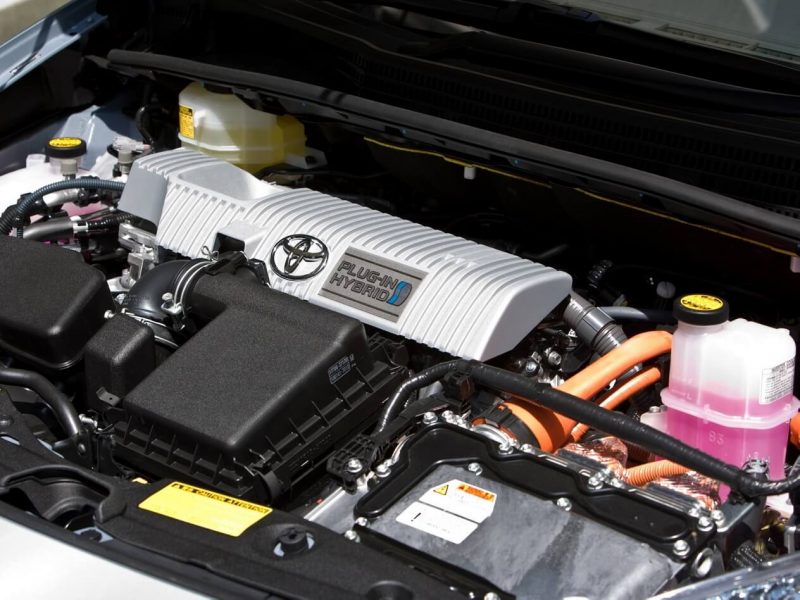
High strength steel is used in the body part of the machine, and some of its elements are made of the original “Japanese” polymer of plant origin TSOP. Hatchback has a rack and pinion steering system, which is equipped with an electric booster. Brake system is represented on the liftback by 4-wheel disc mechanisms, where the front ones got the function of ventilation.
“The brakes are complemented by ABS systems, EBD and other technologies. It is noteworthy that the Japanese company installs similar systems not only in the hatchback, but also, for example, in Toyota Prius Alpha, which is also quite popular among customers. It turns out that experts are trying to maintain and improve all models of their production, which is separately commendable.
Prius III Generation Costeffectiveness and Equipping
The secondary market of our country offers to buy the third generation of “Priusa” from $6272,00. The price of later models can go over the mark of $20384,00. All equipment have:
- Seven airbags;
- Front seat heating function;
- ESP, ABS, EBD;
- Starting the engine with the button;
- BiZone “climate”;
- Audio system designed for 6 speakers;
- The leather salon;
- Full of LED optics;
- Four power windows;
- 15-inch skating rinks
- Rear parking, light, rain and other equipment sensors.
Generation IV Prius Exterior
The way the car looked not only drew attention to it, but also made it fresh and modern first of all, making you look back at the unusual exterior. Since the initial versions did not shine with an interesting appearance, Toyota had to change something.
At first, the shape of the body was quite unattractive and the manufacturer got away with it due to the new hybrid concept, but not for long. Therefore, each time the designers had to change something, gradually coming to what we are now discussing. That decision to which they have come now at registration of an exterior it is possible to name safely aspiration to something new and modern.
Also, the modernization of the exterior was aimed at attracting younger generation of consumers by making a sports and city car out of a hybrid. The main feature was the new design of the Toyota Prius front end. The absence of a false radiator grille replaces the usual black radiator grille trapeze integrated into the bumper.
The optics, as in many modern cars, reflects the gaze of a seriously tuned predator. Angular louvres, strongly curved, clearly fit into the overall picture passing from the bumper, almost along the entire hood. The engine compartment lid is slightly lower than expected and is decorated with minimalistic ribs that complement the image of the headlights.
The parking lights were hidden in the air intakes. A diffuser was placed under the bumper itself, which creates protection when driving on wet surfaces. The “cherry” is the company logo on the pediment. When you look at the nose of the novelty, it seems that it is a typical sports car. And having looked closely it is possible to notice similarity with a new sedan from “Toyota Mirai”. The side of the Prius shows us the eye-catching large doors, which indicates an improvement in the convenience of landing in the car.
On the front doors there are almost the same rear-view mirrors with repeaters of the turntable, which could be seen on the third generation. The wheel arches are impressive and not huge in size. Under the wings you will find stylish discs, among which you can even choose. Of course, the traditional lines and recesses have been completed and are now in the area of the lower rims and rear wings.
Behind the restyle, it hit a few moments. The plafond remains as curved as the previous generation, with a stylish red tint. After the backlight has been updated, the luggage compartment lid is now even flatter and more comfortable to use. And the almost horizontal rear window adds sportiness to the models.
The dimensions of the Toyota Prius perfectly match the comfortable family D-class car. Hatchback length is 4540 mm, width is 1760 mm, height is 1470 mm, wheelbase is 2700 mm, and clearance is 140 mm. “Toyota Prius” has repeatedly proved that its design was based on materials that meet the requirements of European environmentalists and their standards.
In such tests the hybrid always took the first place. However, despite its modern and extravagant exterior, not everyone would agree that the designers’ solutions were appropriate. But there’s nothing you can do about it, because you can’t please everyone, and you can make an impression.
Functional and futuristic appearance is completely subordinated to the impeccable aerodynamics and depicts the vivid character of the most popular hybrid machine. Based on the “YU-BI-SHIN” concept, the designers have fully rethought the recognizable appearance of the vehicle, making it lower and wider.
Generation IV Prius interior
In the new generation of Prius, the insides are not inferior to the appearance, although they have not changed much. Everything is very practical and rational. Prius also keeps up with current innovations. And why change something if the consumer is satisfied? The driver gets a three-spoke cartoon in his hands, which falls well into the hands. Besides, it still has practical additional functions.
In the center of the steering wheel is standardly painted Toyota logo. After it there are no habitual gauges of the control of work of the engine. Further there is a multifunctional “device”, established on the center of “torpedoes”. Next to the built-in touch screen 4.2 inches, to control multimedia devices, climate control unit HVAC and various service buttons.
It should be noted that the system was developed a few years ago and changed little in the moments of restyling, but still pleases with its practicality and ability to provide the driver not only with all the necessary information, but also with high-quality audio equipment. This is where the energy source for the engine is regulated and other features of driving are regulated.
Underneath all this there is an original transmission control center, the location and size of which will have to get used to. Stylishly designed joystick to choose the direction of travel. Next door is a parking brake button, Drive Mode and EV Mode. An innovative feature here is the induction charging in a special compartment for smartphones (just put and charge).
Naturally, the designers have taken care to ensure that the use of all this takes minimal effort and movement, allowing you not to distract yourself from the process of driving. And tactile sensations at the expense of qualitatively picked up material are very pleasant. The doors received semi-coated handles of dark shade. Noise insulation has also been taken to a new level of quality.
The front seats are much more comfortable and softer than the previous generation. A person with a height of about 1.9 m can sit there without difficulty. But the shape and outstanding edges, unfortunately, at bends do not keep the seats in place. However, they keep the correct position of the body that allows you to feel less tired after a long trip.
It is nice that the seats are equipped with a wide range of adjustment abilities. Rear row passengers will also be able to sit comfortably, having enough legroom, except for tall people, because it is the back row that the roof goes down and creates obvious discomfort.
In addition, the panoramic roof, which in tandem with the large side and windshield windows, provides excellent visibility. Behind the back of the rear passengers there is a battery that can be accessed through the boot. Also, the luggage compartment is not only accessible and practical, but also pleases with a volume of 502 litres (57 more than in the previous generation).
After a visit to the Toyota Prius 2017 salon, you realize that the fashion includes futurism, which is still in the “Japanese”. The glossy central console has upset you a little bit. If you believe the assurances of the company, this plastic should not scratch and it is not difficult to look after it. However, if you take a picture of the central console with the camera, every dust will sparkle on the pictures.
At least on its dark part, so a special microfiber will be necessary to take with you. Also, the 2017 Toyota Prius salon has an unsuccessful location of the seat heating buttons. It is unclear why the designers placed them under the central console, in the depths, because they are very difficult to see in this place, and reach much harder.
However, there is an adjustment of the heating intensity and area, which is a pleasure. I would like to thank Japanese specialists for the availability of autonomous electric heater of the salon. Salon Toyota Prius IV generation is the embodiment of functionality and style. The interior space aimed at the driver together with the reduced landing of sports type, helps to adjust to the active driving mode.
Specifications IV Generation
Mower units and battery
The Synergy Drive system combines the operation of two units. The first is a 4-cylinder 1.8-litre petrol engine with 97 horsepower and a torque peak of 142 Newton/metres. It works on the principle of changing the cycles of Miller, which is analogous to the Atkinson cycle.
The main advantage of such work – efficiency and clear work, but there is a loss of power. The second, the electric motor is equal in strength to 73 “horses”. In general, it gives the opportunity to reach 100 km/h in about 10 seconds. Interesting is the fact that the engine running on gasoline is primarily designed to charge the electric motor and is not responsible for the movement. The movement of the vehicle is monitored by the electric motor itself.
If you release the accelerator pedal, all the energy you can take from the reel or brake is transferred to charging. The more braking or reeling you do, the faster the battery will be charged. It turns out that the car is ideal for urban conditions and traffic jams.
Such solutions in the design of the power unit allowed to improve the system efficiency from 38.5% to 40%. Estimated fuel consumption directly depends on improved thermal efficiency, which increased from 38.5% to 40%. Although the car is not eaten out of town, consuming only 3-4 liters per hundred, it is presented as a siticar.
In the city, the car will need twice as much as 8 liters to travel 100 kilometers out of the city. Though the difference seems to be a big consumption anyway remains modest, especially taking into account the ecological orientation. In the combined driving mode, the car consumes an average of 5-6 liters per hundred kilometers.
However, it should not be forgotten that sometimes you will have to charge the battery from the home network, and this also has some costs. Ratisfied that with a fully charged battery hybrid can travel up to 50 kilometers. I would like to note that this installation was introduced by the manufacturer for a long time, but still pleases with its performance.
Toyota Prius IV has a nickel-metal hydride battery with a capacity of 1.3 kWh. I am glad that 163 Nm of torque is already available from the electric motor at the start.
Transmission
The drive is distributed by stepless automatic machine both on the front axle and on the rear axle. The box is represented by an electromechanical variable speed gearbox with a planetary power divider.
Carriage
The fourth-generation Toyota Prius is based on the TNGA platform, which is based on the fact that it lowers the centre of gravity and improves torsional resistance, all thanks to a 60% increase in body stiffness over the restyles. It’s easier to get used to the controls by fine-tuning the independent suspension, which is presented in the front in the form of McPherson levers, and in the back in the form of transversal levers instead of a bending beam.
As a matter of fact, this solution has improved driving safety. In addition to the quality of the materials, attention was paid to weight. This contributed to the weight loss by an average of 100 kg, namely: 113 for the version with a standard battery and 85 kilograms easier to complete, capable of charging from the home network. The brake system contains ventilated disks on all four wheels.
Security
After the introduction of the fourth generation of the TNGA platform, it was possible not only to make the body more rigid, but also to integrate a whole range of security systems into it. Now in “Toyota Prius”, in addition to 7 or 9 airbags, there is a package called “Toyota Safety Sense” (abbreviated TSS).
Laser radar and a camera provide information to the TSS computer. The complex can control automatic braking with the help of Pre-Collision System, as well as recognize pedestrians by Pedestrian Detection program. There are also assistants such as Lane Departure Alert and Steering Assist, Full-Speed Dynamic Radar Cruise Control and automatic headlight control that responds to approaching objects.
Among the airbags there are frontal, side, curtains for all rows of seats, and a knee pillow for the driver. In addition, there are active head restraints in the first row of seats and the Isofix child seat system. Electronic systems have tire pressure sensors, anti-lock brakes and other active safety and dynamic control systems.
They have not forgotten to install an electronic brake force distribution system (EBD), an emergency braking system (BAS), a Variable Stability Control System (VSC+), and an anti-skidding system (TRC).
Since the model meets the latest equipment criteria, i.e. rain and light sensor, as well as the presence of cruise control, rear camera, where there are dynamic marking lines, projection display. Based on EuroNCAP data, the car was recognized as one of the safest, which is why it received a maximum of 5 stars.
Complete sets and prices
From a number of changes that have taken place in the “Prius” model, it can be concluded that compared to the previous version of the model, there should not have been a strong rise in price. Toyota has put price tags on the basic set – in North America $ 25000, and in Europe more expensive than 27000 euros. In Russia, the price for the basic version is $33116,16.
Interesting that already in the basic equipment there are LED headlights, ERA-GLONASS system, projection display, leather interior and 15-inch wheels. And despite everything, the car is popular in both regions. The model received a fairly rich package of features that will serve the benefit of the driver and passengers.
The list includes:
- Cartridge;
- Automated climate control
- Multimedia system with 6 speakers located around the perimeter of the car;
- Heating external mirrors;
- Bortcomputer;
- Electric power steering;
- Swivel column adjustment:
- By inclination and depth.
Safety is ensured by 9 airbags that can save passengers even in the event of a severe accident. All the functions of the multimedia system are not listed, but it is worth noting the presence of a standard set: Bluetooth, AUX, CD and USB input. Optionally, the available package is extended with the installation of a modern GPS system.
The text on the screen can be pronounced by a robot-speaker. All systems are controlled by means of a full-colour touch screen monitor. Among other things, you will find the following in the cabin: a cartoon, rear view camera, power windows and keyless access to the cabin. The safety system can be complemented by an option that includes the Toyota Safety Sense.
Owner feedback
It is clear that most often, such a car is purchased for use in urban mode, where there are a lot of traffic lights and traffic jams. Drivers note that in summer, when many engines start to boil, the internal combustion engine is switched off at all in Prius. Owners talk about the advantages of electrical equipment: steering wheel, air conditioner and pump – everything works independently.
There are no belts, so do not worry about its breakage. The gas-distributing mechanism has a chain. If to pay attention to Toyota Prius reviews of owners among advantages, drivers note presence of capacious salon, good dynamics, mainly in a city, profitability of movement on long distances, reliability and durability, fine electronic assistants on the road, excellent level of safety and good regular music.
The car is managed conveniently and pleasantly, for which it is necessary to give due consideration to the considered suspension. Some owners do not like the mediocre controllability, insufficient noise isolation, loss of dynamics at a speed of more than 100 kilometers per hour, as well as the appearance of the car, which is not suitable for every motorist.
On top of that, I’d like to have an extra battery charge to make sure it’s enough for long journeys. Although a new fourth generation has been released recently, the quality of the materials used for finishing is still limping. Although the seats have become better, but they are still far from the famous German quality. Taking into account our roads, we would like to have an increased height of the ground clearance.
Toyota Prius competitors
The Japanese car Toyota Prius in this niche is not so many competitors, but they still have. This includes the Honda Accord Hybrid, which consumes almost the same amount of gasoline (in a combined cycle) as the Prius. Next comes the hybrid version of Honda Civic, which consumes about 5.23 liters per hundred kilometers in combined mode. As a European variant, it is possible to introduce Volkswagen Jetta Hybrid. The car consumes on average as much gasoline as the Civic.
There are also direct rivals in the face of full-fledged electric machines. The most important one is BMW i3. Although the model looks strange, but to overcome 100 km of the way, it will spend so much money that they will be enough to buy only 1.9 liters of fuel. Do not forget about one of the fastest and best electric machines to date – Tesla Model S.
Pluses and minuses
Pluses cars
- Low fuel consumption;
- Spacious interior;
- Luggage compartment capacity;
- Reliable structure of the hull and supporting structure;
- Good controllability;
- Rich functionality, providing convenient and easy operation of the machine;
- Modern, stylish and dynamic appearance;
- Front and rear LED lighting;
- Good streamline;
- Good dynamics;
- Acceptable suspension;
- Good level of safety;
- There are different electronic systems to help you control your machine;
- Low percentage of exhaust emissions;<
- Perfect for urban driving;
- There are two color displays;
- Reliability.
Cons of a car
- Little ground clearance, which is not only impractical for our roads;
- Pendant is not as soft as you’d like it to be;
- Find replacement parts for Toyota Prius is not easy;
- Insufficient climate control – a lot of time is spent on heating the stove;
- Quality of materials used for interior decoration far from ideal;
- Not always enough power;
- Li>Low battery life;
- Back of tall people will not sit comfortably;
- Design for the amateur.
Summing up
The fact that Toyota is making great efforts to create and improve the hybrid hatchback Prius is certainly encouraging. The structure of the model takes into account not only compliance with ECO standards, but also the needs of the consumer.
Thus, when you buy this car you will find a wide range of functions that increase the ergonomics of the entire interior and allow you to enjoy the pleasure of being behind the wheel of this car. Extravagant appearance will allow you to stand out from the crowd. The spacious salon satisfies almost any customer, especially those with a large family.
Unfortunately, such “eco-mobiles” are not the cheapest variant for movement yet, but we live in the era of innovation, so let’s see what the developers will come up with next. In the meantime, you should enjoy the hybrid version of Japanese hatchback, which can interest even a young customer. The novelty has received LED lighting, improved interior, which already has two color displays and a more pleasant ergonomics.
There is a large luggage compartment, which can be increased if necessary. Of course, finishing materials are not yet of the highest quality, but the car itself is cheaper than its direct competitors, while having a good build quality, technical component and reliability.
Good dynamic performance is ensured, despite the rather modest power units. The internal combustion engine consumes a very modest amount of gasoline, and in fact, primarily works as a “charge” for the battery.
The Japanese have equipped Toyota Prius with the most modern help and security systems. This car will be perfect for families living in the city, who are worried about the ecological system of our Earth.
We advise you to read the article: Toyota History: from weaving machines to cars


